
Bodyswaps: Innovating Soft Skills Training with Virtual Reality
- May 10, 2023
Listen and Subscribe on Your Favorite Platform:
Episode Summary
In this episode of XR Industry Leaders, we sit down with the CEO and founder of Bodyswaps, Christ Mallet to discuss how VR training is changing the way companies and schools prepare their workforce. Bodyswaps’ VR apps aim to help users develop essential soft skills, such as communication and body language, to enhance their employability in the workplace.
Bodyswaps specializes in “off-the-shelf” and “autonomous” VR apps, which allow students to complete modules independently without the need for instructors. Additionally, Bodyswaps has developed innovative inclusion and diversity training that helps trainees recognize implicit bias and foster healthy dialogue around issues of race and sexism.
With their focus on self-discovery, self-reflection, and education by shifting a user’s perspective in VR, Bodyswaps is changing the game in soft skill training for the modern workforce.
During our conversation with Bodyswaps, we discuss the future of VR in education, including the potential for virtual classrooms and remote learning. We also cover advice for new adopters of VR technology, as well as tips on creating a compelling VR demo to impress decision makers.
Join us in this episode to learn more about the innovative work of Bodyswaps and the exciting potential of VR technology in education and professional development.
Key Moments
- Introduction to VR and how Bodyswaps began (00:30)
- Clinical example of virtual reality in depression (07:15)
- Type of content creating today (10:10)
- Current Bodyswaps use cases (11:44)
- The future of VR in education (20:56)
- Advice for someone starting with pilot project (28:50)
- How to create compelling demo for decision makers (30:28)

About the Guest
Christophe Mallet is the CEO and co-founder of Bodyswaps, a leading provider of immersive soft skills learning experiences. Paris-born Christophe, following a decade of experience in social media and VR-based storytelling, co-founded Bodyswaps in 2019 with a mission to make soft skills training autonomous, affordable and effective. Chris believes everyone has the potential to learn career-boosting soft skills, given the right tools, and Bodyswaps are harnessing AI and immersive technologies to make this possible. Chris is an international speaker and regular podcaster on VR and learning.
Links and Resources
Learn more about getting started with XR in our ultimate guide to managing VR training for work.
Episode Transcript
Brad Scoggin: Hey there, welcome to “XR Industry Leaders” with ArborXR. My name is Brad Scoggin, and I am the CEO and one of three co-founders of ArborXR. And we’ve had the opportunity of working with thousands of companies since 2016, and we’ve learned a ton about what it takes for XR to be successful in your organization.
Will Stackable: And I’m Will Stackable, co-founder and CMO. This podcast is all about interviewing the leaders who are on the ground making XR happen today. True pioneers in the space from Amazon, Walmart, and UPS to Koch, Pfizer, and beyond to uncover the pitfalls, lessons learned, and secrets that you can use to help grow XR in your organization.
Brad Scoggin: Well Chris, thanks for sitting down with us today, I’m excited to jump in.
Christophe Mallet: Same here, very nice to be here.
Brad Scoggin: So always love to hear about your personal journey, kind of. So maybe start by just sharing with our listeners for you, what was your process of moving into XR personally?
Christophe Mallet: Yeah sure, so as you may already hear I’m French, but I live in London, I’m in London right now. And I moved here in 2010. And until 2015, I worked in social media trying to convince CMOs that it wasn’t a fad for teenagers, having no idea how far it would come for better or worse. And in 2015 I was starting to look around looking for interesting people, there was this VR thing going on, which from a storytelling point of view well, was quite interesting. And I did some research and I met one rainy February afternoon in a pub in Shoreditch, right? With Julia, who had brought the DK1, I don’t know if you remember the Oculus DK1. So massive gaming laptop, the two black towers, the huge headsets in the middle of a pub, right? So everyone’s looking at us, and he shows me an experience called The Night Cafe, have you tried that one?
Brad Scoggin: Hmm, no.
Will Stackable: No, my first on the DK1 was the rollercoaster, which made me sick but.
Christophe Mallet: Yeah, like that’s pretty much everyone’s first experience. And obviously the first one we created was rollercoaster, which was a terrible idea, and everyone’s made that mistake. But that day he showed me the Night Cafe, which is the name of a painting by Vincent Van Gogh. And a guy had recreated the painting in 3D, right? So applying the same brush to the environment, but you could walk inside a painting. And we all have that, “My first few seconds in VR,” story. And that was mine, it was so powerful, I’ve always been into storytelling. And so, yeah, I essentially picked up my jaw from the floor, and a few weeks later I quit my job and started a VR storytelling agency with Julia. So it was the beginning, so we did roller coasters, we did 360, we did, you know, like embodied experience, a little bit of everything, that’s how it started.
Brad Scoggin: And that’s 2016?
Christophe Mallet: That’s, yeah, 20, yeah, 2016, 2017.
Brad Scoggin: 2016, okay. Yeah, my first experience was not as cultured as yours. Mine was the zombie training simulator, but I had the same, I mean, to your point, like it’s the same, oh, wow, my jaw’s on the floor. How do we move into this? So tell us then from that point, you jump in to where you are today. Talk us through that journey, and I’m very curious too, as you share the journey from 2016 to Bodyswaps, maybe also just weave in your why. You know, you talked about working with social media before, and then being impressed by this new technology, so maybe weave that in as well.
Christophe Mallet: All right, I’m gonna start with the why, and then do a big detour.
Brad Scoggin: Perfect, perfect.
Christophe Mallet: When I did my first internship, I was in a business school. As you may notice I stutter sometimes, and it used to be worse. I did my first internship at a, you know, suited up strategic consultancy firm in Paris, which I’m not going to name. I hated every minute of it, but I work hard. And at the end of the six months, my n + 2, who had never really meet me face-to-face, comes to me and say, “All right, we’re gonna offer you the job “when you graduate we think you’re smart, “but because you stutter, don’t expect to go too far, right? “We’re not gonna put you in front of the client.” And that’s obviously the worst thing that you can say to anyone, so I couldn’t pick up the phone for six months. And a year later, that was my last year at business school. We had a weekend seminar, which is a thing you hate when you student, so I ticked a box without really knowing, it was called Managing Crisis. I arrived on the Friday morning in a room, and 12 chairs in like the semicircle. And a teacher comes in with that long hair and sneakers, which was very unlike the business school was in. And he looks at us and he goes, “Welcome to the improv theater class.” And I’m like, “The what?” And I wanted to jump out of the window, but I had no choice, like I needed a grade, I couldn’t go out. So he goes like, “Yeah, the first exercise, “two of you are gonna go in the middle of the room. “One is going to do a political speech “in a language that doesn’t exist. “And the other one is be to translate it “sentence by sentence.” And you know, my heart was in my stomach, it was horrible. I was like, “Well, okay, let’s go for it.” And, you know, at that time I was so low confidence-wise, then I went for it, and it’s the most fun I’ve had in a classroom for two days. And at the end of it, I was like, “Well, I can’t pretend to be a tree, “I can invent a new language,” I can go from being a parent to being a child like that.” This is bloody amazing, right? And so I’m putting that, that’s kind of the power of soft skills. I didn’t know what it was back then, but that’s what I realized. My manager had terrible soft skills, and that guy here told me something interesting. Going back to VR 2016, 2017, we had the agency, we did like a 360 movie for a spy show. We did a climbing experience for Adidas, a raising the Champion’s League cup. It was all super fun, and in parallel to that, we were giving classes in a business school in Geneva around VR as a new storytelling frontier for marketing. And always saying how, because it’s embodied, the nature, the role of the creator, the role of the storyteller VR is different. You don’t control the camera, you don’t control the editing, but you need to think of your audience as yeah, as an embodied character, and you have to be a lot more subtle. And so we are talking a lot about the UX of storytelling in VR and referring to a body of academic research that started to emerge in both the UK and the US around 2015 around embodiment, right? So there’s been a lot of studies, what happened to your behavior in VR, but outside, conscious and subconscious, short-term and long-term when you are going to embody someone of a different race, of a different height, of a different age, you know, all of that. And I always use those example to justify the power of embodiment as a behavioral change machine. You know, like you had Chris Mill talk about VR is the Empathy machine. No, first he stole that sentence from Roger Ebert, who’s a cinema critic. And two, VR is more than an empathy machine, it’s a behavioral transformation machine. And there was one experience by UK researcher called Mel Slater. He had decided to say, if you’re depressed, like profoundly clinically depressed, you have too much criticism towards yourself. You don’t have enough empathy towards yourself, so let’s try and externalize that. So you had this idea of putting 15 patients, I believe, in a motion capture suit, created an avatar that looked like them, put them in front of the mirror in VR. And after taking virtual ownership of their body, they would be confronted with a little girl crying, the character of little girl crying. They had to say nice comforting words to that little girl for a few minutes, and then they would swap bodies with the little girl. And essentially watch themselves back give those comforting words, essentially they were giving themselves empathy. And the results were like significant and sustained, and this was a really kind of jaw-dropping experience. And in 2019, we are approached by Sage, the publishers in education, and it said, it was the first time we had an education lead. It wast a spy story or something for Adidas, it was like, “We wanna try VR to train nurses in psychiatry, “and we want to put you in the shoes of a nurse.” Oh no, “We wanna put you in the shoes “of a suicidal patient.” Which if you think for a few seconds, being suicidal is not an audiovisual stuff, right? You cannot visualize what it’s like. And so there’s always this danger of, you know, I’m gonna put myself in someone else’s shoes in VR. And that’s when we had the idea and say, “Well, this experience by Mel Slater, “the whole body swapping stuff is brilliant. “Couldn’t we spin it on its head, “and instead of it being about the patient, “it can be about the practitioner.” So you’re gonna watch yourself give words of comfort to a suicidal patient to learn about how you come across as a doctor or as a nurse. And so back then it was only, there was just one prototype we did alongside like a London Zoo experience under the Thames watching fish, that literally those two in parallel. And then we get amazing feedback, so we said, you know, one accelerator after grands, after all of those, we said, “Okay, let’s drop the agency completely, “and focus on Bodyswaps.”
Will Stackable: So interesting, so you gave two different Bodyswap examples. I’ve also heard of the one, there’s an experience where you go in and you’re sitting in front of Freud, and he’s behind a chair and you’re sharing your problems. And then you flip and you’re now Freud, and you get to hear yourself share your problem, and maybe that’s connected. Can you talk a little bit about the types of content you’re creating today? And is it all connected to that idea of changing and giving people a different perspective, and kind of seeing themselves in a mirror in a way? Or have you branched out beyond that using other techniques as well?
Christophe Mallet: I think it’s evolved. The pedagogical core remains around this idea of a flight simulator for soft skills, right? So we’re gonna give you a realistic simulation of a workplace scenario in which you’re going to interact with virtual characters in different way, but it’s safe, right? Because those characters, they hear 24/7, they have no judgment, they have no feelings. So, you know, you can’t hurt them. And one of the interactions is indeed that, you know, you speak, you watch yourself back, and you get some data. But around that we build a whole like scaffolding of exercises. You know, learn to observe characters that are good and bad at what they do, learn to make a choice by choosing the right questions, self-reflect in different ways, et cetera.
Brad Scoggin: Talk to us then, you know, I mean, is the focus now primarily education? And if so, I mean, are there some other specific use cases that you can share, any that you get particularly excited about?
Christophe Mallet: Yeah, so it was a bit of a strange journey ’cause we started in nursing education. Then the second prototype we did not a prototype, the first really paid big clients was safeguarding, safeguarding for NGOs. So imagine you’re working for an NGO, and someone working for the NGO, or maybe a refugee comes to you and says, “This happened, you know, “I’ve been sexually assaulted.” How do you train in advance to have that kind of conversation? All right, ’cause those are super emotionally charged, there’s a lot at stake, things can go wrong in many ways. And the way people train for that today is, you get into a windowless basement and there’s a middle-aged white dude going through a PowerPoint, and at some point you’re gonna do a role play pretending that Dave is a 17-year-old refugee. It just, that doesn’t work, it’s inconsistent, it’s expensive, there’s no hands-on practice. You’re ticking a box. So that’s how we started, it was safeguarding. And then we moved back to what we thought we knew, which was the corporate world, so we did active listening, clear communication, inclusive leadership. And we kept getting a lot of inbounds, We were, you know, selling to corporate clients and still are, and I think the adoption curve now is starting to catch up in ’22. But we had a lot of education institution coming to us, and saying, “You know, we wanna try new modalities.” You have to factor in that, you know, the pandemic, right? So there was this whole shakedown, I was like, do we need to reinvent ourselves as education perspective? Some things worked during COVID, some didn’t, but there was clearly this opening of, hmm, maybe remote learning doesn’t have to be shit. Maybe we can give access to underserved population to something a little bit better than a recorded video or a click through deck. And that’s what was interesting with education institution is, I’m gonna say that a little bit bluntly, but for a bank to invest in active listening simulation in VR for middle managers is often perceived as a nice to have, that’s hard to measure. For a further education college in the UK whose funding depends on their ability to help their students actually get job and make a living, preparing them for job interviews is mission-critical, it’s so close to their heart. And because of that, they are much more keen to try new things. They are educator, that’s who they are, that’s their nature. And so they’re really happy to try new ways of educating as long as it delivers. And so that’s why counterintuitively, it’s actually a lot faster to start working with education institution than it is sometimes to work with corporate, at least in our experience.
Will Stackable: I’d love to zoom in there a little bit. There’s a lot of educational content being created, and some of it’s very subject-matter-specific, frog dissection, et cetera. What you’re talking about with job interview simulation, could you share that story specifically? And then if there’s any other, it seems like you guys are finding an interesting niche in terms of the education space that isn’t necessarily very deep in subject matter, like a, you know, frog dissection, but it’s a life skill. Can you talk a little bit about that example, and if there’s any other ones that come to mind?
Brad Scoggin: And also I’m just thinking too, you know, talk to me as if I were a skeptic. Okay, so you know, how do you help someone do a better job at a job interview, you know, by spending time in a VR headset? I mean, yeah, walk us through that.
Christophe Mallet: You guys went to university, I presume, right? How do you train for job interviews?
Brad Scoggin: Say it again.
Christophe Mallet: How do you train for job interviews, do you remember?
Will Stackable: I think there was a gateway class where you… Yeah, I mean, you’re reading text, maybe you do some simulation in the classroom and you take turns partnering up, but it’s-
Brad Scoggin: I’m thinking I had no training .
Will Stackable: Minimal to no, very basic.
Brad Scoggin: That’s a good question.
Christophe Mallet: How good were you at your first interview, do you remember? Versus how then you would be now?
Brad Scoggin: Yeah, no, that’s a good point, not great.
Christophe Mallet: I think the idea-
Brad Scoggin: I think I showed up, I thought I just had to show up with a good resume, and the guy afterward was like, “Hey, you have a good resume, but you can’t just show up, “You have to actually engage in the interview.”
Christophe Mallet: So it’s really like being good at a job interview is something you learn, like there’s a set of techniques that you can acquire regardless of your experience and how good your CV is. And you know, the basics are how to sit, how to look at someone, how to breathe to manage your anxiety and your nerves. Then you’re like, okay, you might think you are a… I’m a team player, all right? Great, everyone says they’re a team player. No one has ever said, I’m not a team player in an interview. How do you prove that you’re a team player? How do you build a story from your experience that shows that you’re a team player, and that relates to the company and the job you’re applying for? Then if I throw a weird question at you, like, would you rather be feared or loved? Okay, weird question, you probably didn’t prepare for it. How do you answer that? You’re probably gonna say, “I prefer to be loved because love is nice or whatever.” That doesn’t matter ’cause that’s not the meaning of the question. The meaning of the question, is I want to get to understand how you react to something that is unexpected. And so you’re gonna learn the CAR technique, which is context, action, and results. Why are you asking me the question? Okay, I’m gonna give you, et cetera. So those are set of techniques. If you master them then you can do a simulated interview in VR, or with your friends, or with a career advisor, and you will be a lot better. But in the classroom and even with career departments, you don’t get to learn those, right? You don’t get to do the drills. It’s like being a football player, a soccer player as you would do it and play 11 asides all day every day. You don’t do that, you do drills, right? So that’s why it’s interesting the whole VR approach ’cause you let people practice autonomously, do the drills, stack up the techniques, and then apply them in a simulation.
Brad Scoggin: Are you utilizing AI?
Christophe Mallet: So to an extent we’re using AI, so we’re using speech to text, and then we’re performing analysis on semantics, on speech to motion, then there’s the whole body language and kinematics. What we are not using AI for, which we would like to, but I don’t think the state technology allows it is to have infinite believable conversations with avatars. At the moment we have a set of exercises, so we will get there eventually, but I just don’t think AI is just quite there yet for something as subtle as telling a suicidal patient how she can cope better with her days. You would need a subtlety of reading emotional input that just doesn’t exist yet.
Brad Scoggin: So you’ve got universities that are willing to pay for the content because they’re seeing an uptick in their students getting jobs. I mean, that’s kind of the bottom line I guess, that’s what motivates them to do it.
Christophe Mallet: Yes, I mean, there’s many reasons why universities want to do it. So we have a grand with MECAD that’s open at the moment, so we’re receiving applications. So I’m reading the applications all day every day. And one of the question is, what challenges are you looking to solve? They’re very diverse. One is about the access, right? There’s access to great learning for underserved populations that cannot pay $90,000 a year to come to the campus, so equality of education is a big one. Another one is to plug that gap where you might have, you know, well educated parent that put you in a good institution, and you know how to come across with impact. And some kid who’s just as smart and just as motivated wants, simply because they didn’t have 20 or 25 years of being surrounded by the right people in the right environment, and you can level the playing field a little bit. And I think a lot of education institution understand that a university or a college is not a place anymore it’s a force. And more and more you’re not measured by the salary you get your students, or the amount of papers that are published every year in academic journals. You’re measured by the impact you can have on the community around you. And I think the world is changing in that way, and that’s very good, so it’s not just getting job. I think there’s an idea of bigger impact and the SDG number four around quality of education and all that.
Brad Scoggin: Definitely.
Will Stackable: Where do you see virtual reality and augmented reality going in education specifically? I mean, it seems like there’s a beachhead here with job simulation, some of these soft skills, but where do you see it going?
Christophe Mallet: What’s interesting with some of the colleges we speak to, well, two years ago when we were talking to educational institution, we had to sell the hardware as well as the software. And when we sell, I don’t mean sell the actual object, I mean sell VR as a medium for learning, right? And it’s a little bit like you invented Photoshop, and you had to explain to people what a keyboard is, right? or a screen, and no one would buy a laptop just for Photoshop, or some people might, but it’s much hard to sell. Now we get a lot of colleges that come to us and say, “Hey look, we’re using VR “with our healthcare students for this, “we’re using VR with our sports students for that, “with the business students for this.” And I don’t know how fast we’re gonna get there, but we’re gonna reach that kind of like utility points where there’s a threshold from which the number of use cases per institution makes it worthwhile for individuals to have their own headsets. So at the moment VR is more often than not in somewhere in the library or dedicated VR lab, some you know, borrow your headset, bringing home type stuff. But that’s because, yeah, you wouldn’t ask your students to buy a headset if they’re gonna use it five hours a year. But there is a point where it’s going to become a search screen. If you think about it, your quests cost what, $300? The price of a book, an academic book is $75 to $100. So it’s not that crazy, so when we reach that utility point, so then you’re gonna start seeing some institution deploying at real scale up until a moment, like right now you wouldn’t go to university if you didn’t have a laptop and a smartphone, right? It would just be weird. And as I think at some point we are going to reach a stage where mixed reality, I don’t know exactly what the you know, the split is going to be, of course, but that’s going to be your search screen. And that’s going to be the, there’s idea of the university of the future organizing layers. And the core is the campus experience, that’s where the face-to-face is the most important. And as you go out in layers, you go further into the metaverse, right? And the outer layer is students who never set foot on campus. And how do you give those students an experience that’s as close as possible, not as in oh, the walls of the the virtual university look the same as the real thing, I don’t think it’s the point. Just the sense of belonging to a community, the engagement you have with the learning is comparable. And obviously that outer layer is the accessible one, right? It’s the one where you can study at the best university in your world without having to you getting debt for the rest of your life. So I’m hopeful, and that’s maybe wishful thinking, but that immersive technologies in general arguing to be the conduit that enabled this whole vision of, you know, the move to the massive online courses that kind of took off, but not really because the engagement dropped very fast. I’m hoping that that’s the technology that’s gonna pass the threshold of engagement to make remote learning fun.
Brad Scoggin: Yeah, I think what’s interesting, I mean, we’re seeing a lot of really powerful results from different companies we work with when it comes to either retention, or reducing time to learn. And I mean, some very significant data. And to me, you know, listening to you talk, it’s like, well that’s great and that’s really important, but that’s kind of half the equation. The other half is the accessibility, which makes it even more exciting-
Will Stackable: And the engagement.
Brad Scoggin: The engagement, right?
Will Stackable: And the ability to have communities online, and yeah,
Brad Scoggin: Exactly. Yeah, and so to me, I mean, it’s just powerful. So how far away are we from that in education? What’s your prediction?
Christophe Mallet: To to be honest, I’m not a good crystal ball case. If I was, I would be probably like richer now, I wouldn’t have invested in crypto like that also . I don’t know, I just know 2022 has been a very, very interesting year. You know, every year we say, “Oh, it’s gonna be the year in VR for us.” We’ve seen adoption, we just signed a deal with a group of 10 colleges in the UK who bought 500 headsets, and a three-year license. And they’re planning to train every single one of their students on job interview, and presentation skills. And we’re not talking like Ivy League innovation budget to spare, no, no, no. That’s going to be core part of the curriculum, and that’s new, rights? ‘Cause that’s when you cross the threshold from innovators trying to validate stuff, and push out some research paper, which we need to get as the early majority. That’s, everyone’s gonna have to do it, and they’re not gonna do VR because it’s fun or new, they’re gonna do it because it’s the best, most efficient way to learn.
Brad Scoggin: Because it works. Yeah, I mean we’re definitely seeing, it feels like, you talk about 2022, I mean, last year when we would go to conferences, it felt like a topic of discussion was still, does VR work? Where this year it’s felt more, how do you scale VR? And so you talk about the challenges a year or two ago of even selling the hardware, you know, or getting buy-in to the technology, and not just being kind of this fun thing on the side. What challenges today? Like what are the challenges you still face when you’re gonna go roll out 500 devices across 10 universities?
Christophe Mallet: That’s it, I think that’s the biggest challenge, and I don’t know how to, so one thing we say to institution is, for every pound you’re going to spend on hardware and software, you need two pounds for change management. You need to procure the hardware, you need to manage the fleet, you need to train your facilitators, you need to communicate to the faculty, you need to communicate to the students, you need to measure the results, you need to… It’s never ending, it’s the study of the whole product model, right? You can have the best VR simulation in the center, if you don’t have all the human element around it to make it happen, it’s never gonna happen. And yet, coming to your point, obviously you guys at ArborXR you exist to solve that challenge, and that challenge is real, and that at the moment is almost a glass ceiling when it comes to scale that is not related to the appetite from the learners, that is not related to the appetite from the faculty, that is not related to the technology itself, whether it’s a performance of the cost. It’s related to that, how do we scale? How do we go from the one laptop in the office to everyone having one at home? That’s the era we we’re in right now, I think.
Will Stackable: That’s interesting. If you were looking back, I mean, you’ve been in this for a long time now. There’s a lot of people who are just now getting started. And particularly maybe if we dialed into schools and universities that are looking at doing a pilot project, what’s the advice… I mean, you gave a great piece of advice there to spend two pounds for every one pound on hardware and software just on, you know, the training and all the other stuff around it. But what other advice do you have for somebody starting with a pilot project?
Christophe Mallet: A couple, one is, if you have a trouble with buy-in. So what what we found is generally when we enter universities, it’s really the dean that comes to us and pushes it down. It’s quite often someone who is a VR champion, an educator, or someone who works in library, or in learning innovation is like, “I wanna bring it to the campus “’cause I know it works, I believe in it.” But so you need to help them get that buy-in, and it sounds very, very silly, but to get buy-in you need to put headsets on people’s heads, otherwise they’re just not gonna listen to you. So part of the equation is, get people to put headsets on. The other part of the question is run your pilot as small as possible, there’s a lot of free, I mean we do it, but I’m sure most vendors would do it. You can get like trial licenses for free, you can get a couple of headsets for $500 if you go refurbished even cheaper. And most apps have data, they’re like built in the app, and if they don’t you can run like questionnaires with Google forms or, you know, and so if you get to your faculty member and said, “Try it out, get that wow effect that we discussed, you know, the Van Gogh or the rollercoaster, like get the wow effect and see what the students are saying, then you can generally unlock some buy-in funding to do something a little bit more significant.
Brad Scoggin: So let’s say you get the dean in the room, he’s gonna try put on the headset for the first time, what’s your go-to content for that, go-to experience?
Christophe Mallet: Well, it’s Bodyswaps.
Brad Scoggin: Well, yeah, you got a lot of them though, I’m saying which one if you’re gonna pick one, and so you’ve got five minutes, yeah.
Christophe Mallet: Yeah, so well exactly. So we learned the hard way before we were like, Oh, which module do you wanna do? The general inclusion or the job interview? The job interview one is 90 minutes. And even the general inclusion, which is one of the shortest, you only get to do the bodyswaps, which is our wow moment after about 13 minutes. That’s just too long in the context of a demo.
Brad Scoggin: Yeah correct.
Christophe Mallet: So we build a medley sort of module that lasts eight minutes and you do little bit of this, a little bit of that, and you do that, and so you get to experience the breadths of the pedagogical approach without actually doing the learning. It’s more about, okay, I get how this works, I get the quality of it, and I get pedagogically what I could do with it.
Will Stackable: That’s brilliant, for anybody listening I’m just gonna highlight that. That’s such a great, I think nailing the demo, oftentimes with key stakeholders, you only have one shot, and they need to get that aha moment that may be for some it happens immediately, so I love that. So eight minutes and they get a range of different types of experiences, and they also get to see your approach.
Christophe Mallet: Yeah, and we do something that is maybe slight, no, I wouldn’t say sneaky, but I’m gonna explain, it’s gonna make sense. So the first element of the medley comes from the gender inclusion demo. And in that modality we call it in observation, you’re meeting with Sam and Sophie. So you have a body, you work in that company, and you see those two characters around the table and they’re coming to you to give you progress on a project. And your job, they’re gonna talk to one another, and your job is to click on the trigger every time you hear or see Sam on the left say or do something that’s inappropriate towards Sophie. And at the back you have the scream, you have 10 shots, right? And you have eight behaviors to pick. And you essentially scored in real-time. If you get it, it appears on the screen. If you click and you make a mistake, you get a noise. When in the room, they’re generally more than one stakeholder, which means there’s one that is in VR being essentially assessed in real-time on their capacity to identify a sexist asshole whereas everyone else is looking at them. No one is bought that moment ever because there is a lot,
Will Stackable: That’s hilarious.
Christophe Mallet: There’s little bit at stake, so that works quite as well.
Brad Scoggin: That’s funny, and do you tie into like the existing LMS at these universities? Or how do you connect into kind of the overall curriculum?
Will Stackable: And LMS is learning Management System, it’s what universities use to track user progress and restore it all.
Christophe Mallet: So oddly enough we hear a lot about we would like to integrate it, but at the moment it’s has materialized only in a couple of times. I reckon that further down the line it will be systematic. What we hear maybe more about from universities and colleges, I talked about that, you know, that point of utility, the idea that you need to, the more use cases you have in any given single institution, the more, you know, VR is gonna start to be embedded. And what colleges and universities tell us is, well there’s those 32 apps that we would like to use, we love them, we tested them, they’re great, but they have 32 different pricings, 32 different platforms, different stakeholders, different data privacy policy and it’s a nightmare. And so I’m waiting for an entity to act as the distribution middle ground that makes it easy for the institution to go, “Okay, here’s the catalog, “I wanna buy this, and this, and this, “for that many users for that long. “And I know by clicking here “that I make sure that the data is used properly “because it’s been validated, and so on.” And I don’t know who’s gonna do that, is it gonna be one of the manufacturers? Is it gonna be one of you guys? Is it going to be one of the big players existing in the industry? That’s gonna be very interesting to follow.
Will Stackable: Interesting, we’re coming up on time here, but I’ve got a hot take. I know you said you don’t do crystal balls, but here’s one that I think you maybe have a good answer for. So 10 years from now, looking back, what surprises you about XR? What’s something that surprises us?
Christophe Mallet: One, I have absolutely no idea ’cause I believe in Amara’s Law, do you know Amara’s Law? You’ve heard about that idea?
Brad Scoggin: Yeah sure, tell us.
Christophe Mallet: So Amara’s Law is, with new technologies, you tend to overestimate what happens the first five years, and to underestimate what happens the following simply because there’s a compounded evolution that-
Brad Scoggin: Yeah, right.
Christophe Mallet: And so having started in social media in 2009, I had no idea that it would lead to Trump being elected, but to also the Arab Spring, and that you would have TikTok and that it’s. So I honestly, I cannot answer your question, I think. I don’t think any of us has, if I ask you what are gonna be the top three use cases for extended reality in 2031, I don’t think any of us would get the three of the top five right. I just don’t think it’s possible yet.
Will Stackable: That’s a fair point. Okay, I’ve got one more for you then. And this could be on any range of topics, but when you look out into the future a bit, and again, I know you’re not, when you look in the future what are you most excited about when it comes to AR, VR, AI, crypto, blockchain, metaverse? Like what gets you personally excited?
Christophe Mallet: There was this analogy when I was teaching in engineer, I was doing about augmented reality, and mix reality, and VR, and there was decided that when you create a new VR, you’re god, and when you create for augmented reality, you’re shaman. And what I mean by this is that in VR you create something that doesn’t exist, right? You create ex nihilo world in which you’re gonna be entirely embodied. Whereas augmented reality, it’s a little bit like a shaman in the way that you making a layer of information appear where it didn’t exist before. Let me give you an examples. You could be at a conference, and you have your mixed reality glasses and you turn on the LinkedIn app and suddenly above everyone’s head, you say, oh, here’s an investor, here’s a client, here’s a vendor. You could have a dating version of that, you could have a nature’s loving version of that where you see what tree that is. You could have a historical version of that, where you walk in solo in London and you have the music at a history of the neighborhood. And I think connecting the humongous digital layer of information and contextualizing it visually in real-time as you go about your life essentially reenchanting the world. That I think is very, very interesting. Scary as well, but exciting.
Brad Scoggin: Yeah, it can be a little scary. But Chris, this has been really, really good. We appreciate so much your time, I know you’re a busy man. And we’ll have info about how our listeners can find Bodyswaps. But if people want to hear from you specifically, is LinkedIn the best place to find you?
Christophe Mallet: Yeah, you can find me on LinkedIn. I’m also on Twitter, but I don’t think they sent a single tweet besides complaining to airlines for about five years, so that’s probably not-
Brad Scoggin: Well, that actually sounds interesting. I may wanna follow you for that reason, but-
Christophe Mallet: It works very well, it’s kind of a shortcut to getting heard.
Will Stackable: That’s awesome.
Brad Scoggin: That’s great. Well, it’s been good Chris, look forward to chatting with you again soon.
Christophe Mallet: Cheers, likewise, bye guys.
Brad Scoggin: Well man, Chris is a very impressive guy, and to me, you know, we talk a lot about the learning enhancements that companies are finding from VR in the training space, but listening to Chris talk it’s like really the same thing is happening in education. And I leave that episode feeling really excited about what’s gonna happen for VR in the EDU space.
Will Stackable: Yeah, they really are cutting edge. Going back to my, you know, background as a marketer and as a video storyteller, I just think it’s so fascinating his focus on embodiment and using VR. We’ve all talked about VR as an empathy machine, but the idea of VR as a behavioral transformation machine, it got me excited, made me think that we’ve all had that experience watching a movie and feeling transported. We’ve all put on a headset and stepped into somebody else’s shoes, and Bodyswaps is using those mechanics to really make a difference in the world. So it gets me personally really excited.
Brad Scoggin: Absolutely, well, thank you all so much for joining us, and don’t forget to subscribe wherever you consume podcasts, and we look forward to seeing you next time.
Never Miss an Episode
Get notified in your email inbox when new episodes go live.
Share this Episode:

Never Miss an Episode
Get notified in your email inbox when new episodes go live.
Episodes
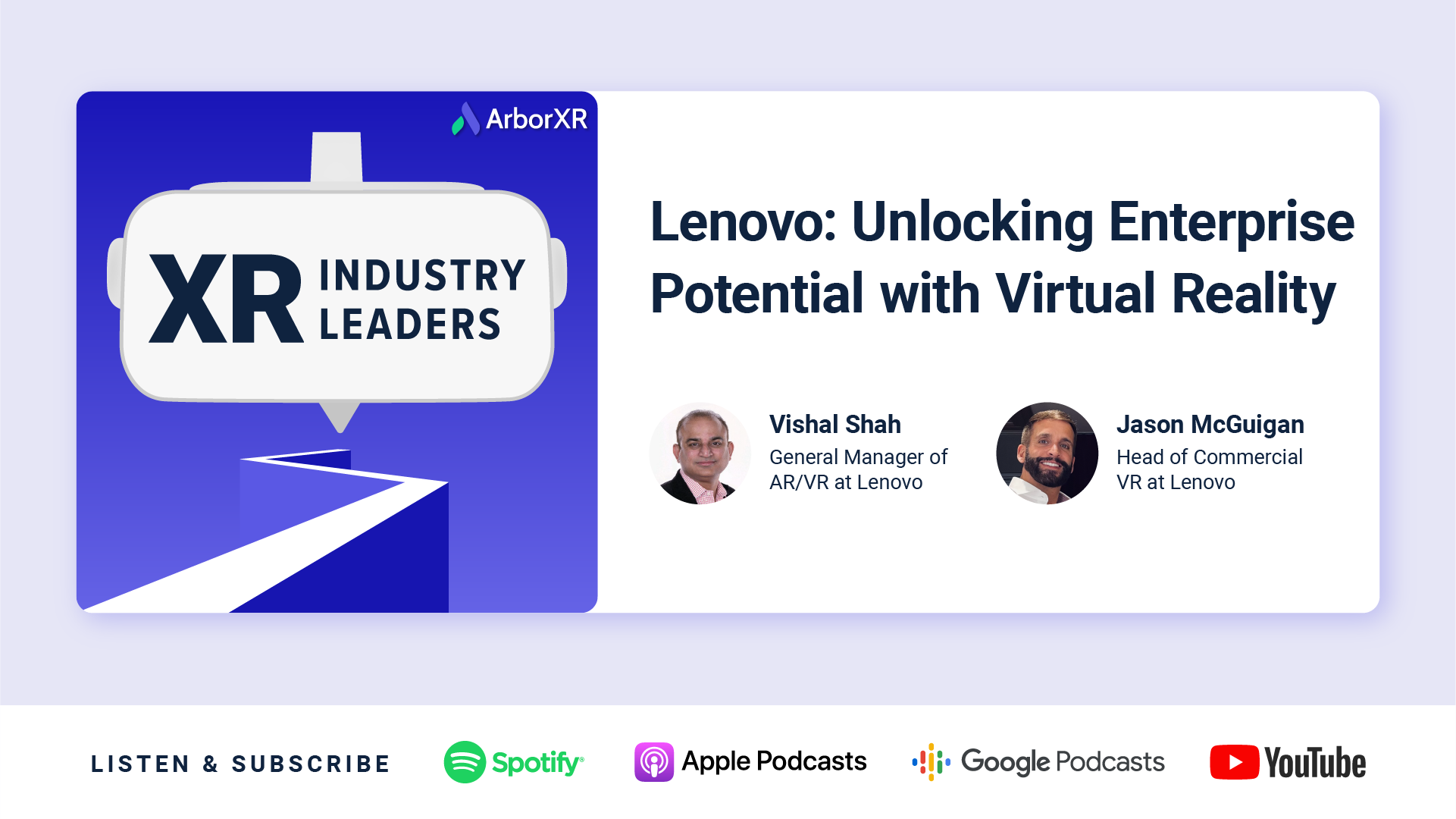
Lenovo: Unlocking Enterprise Potential with VR
Dive into the dynamic world of extended reality (XR) with Lenovo’s Vishal Shah and Jason McGuigan as they unravel Lenovo’s new enterprise XR solution: the Lenovo ThinkReality VRX.

PICO: Practical Enterprise Applications in XR at Scale
Explore XR’s future with PICO’s Amir Khorram in XR Industry Leaders. Insightful discussion on VR enterprise solutions, partnerships, and industry adoption.
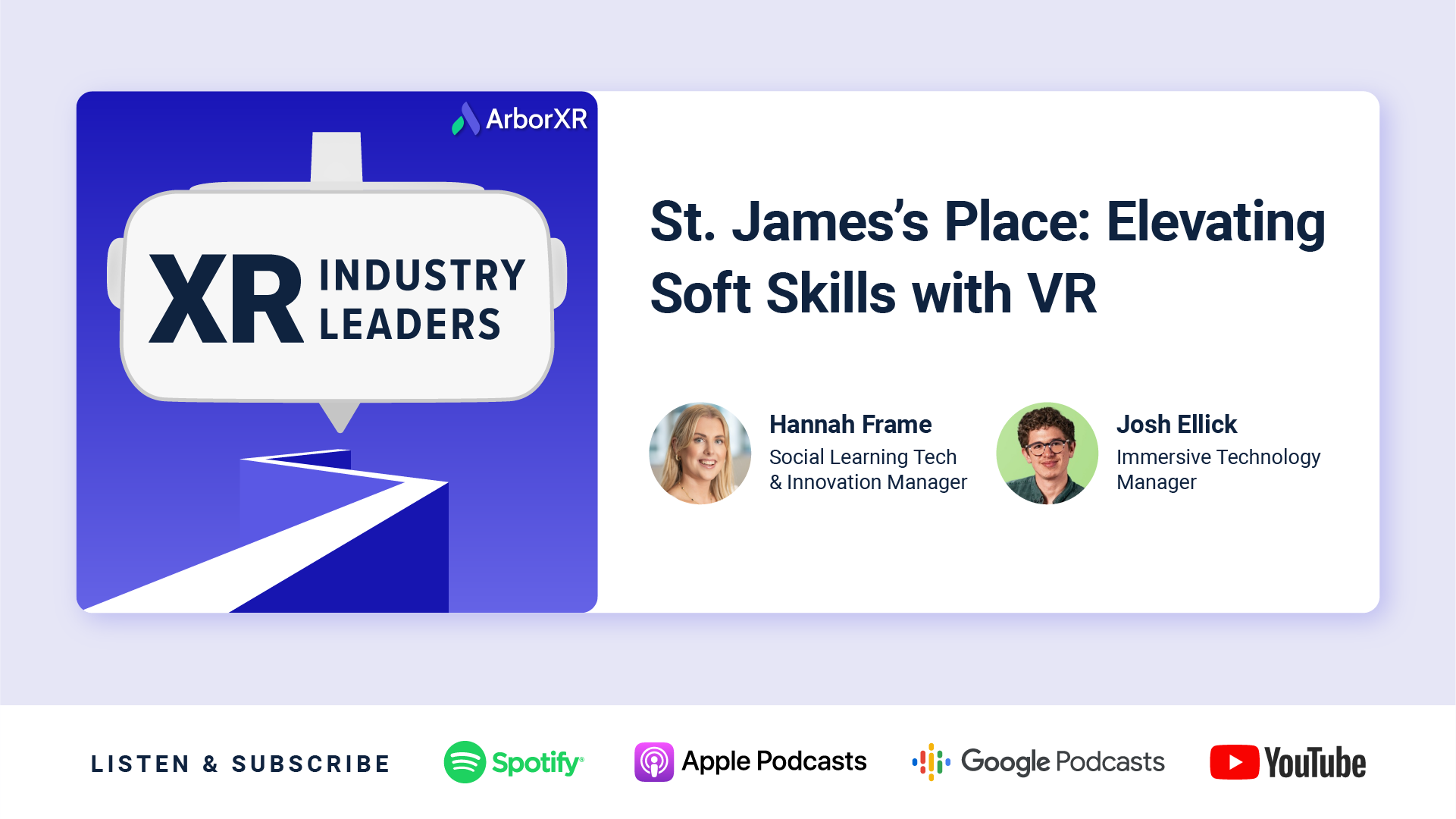
St. James’s Place: Elevating Soft Skills with VR
Hannah & Josh St. James’s Place discuss using VR to train advisor soft skills, challenges of managing headsets at scale, lessons on user adoption, and content development.
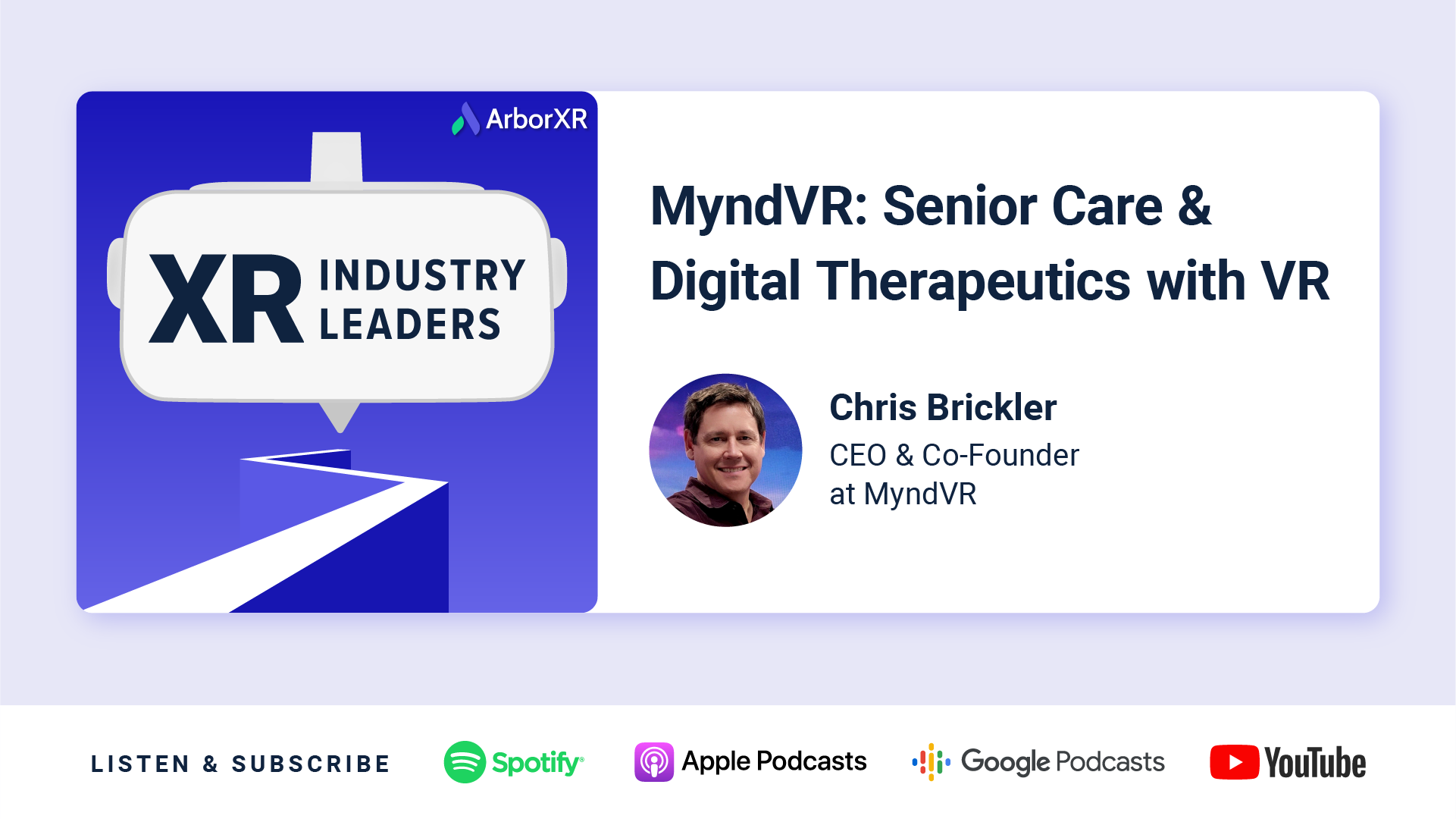
MyndVR: Senior Care and Digital Therapeutics with VR
Chris Brickler shares how VR therapy improves memories and care for elderly patients, and the challenges of scaling VR across health senior care facilities.
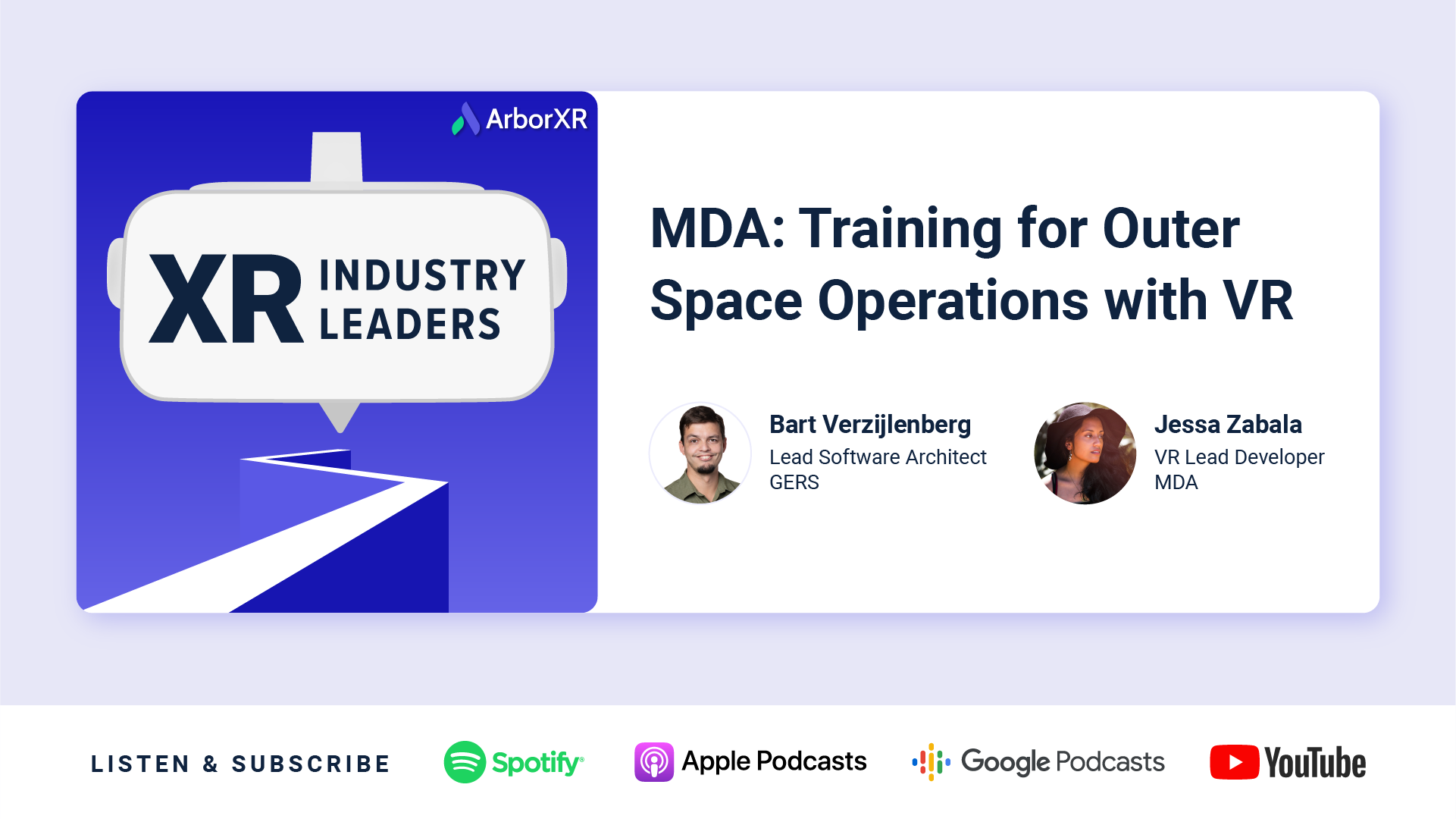
MDA: Training For Outer Space Operations with VR
Discover how MDA leverages VR for astronaut training, mission planning, and onboarding. Gain valuable insights into implementing immersive technologies at scale.

Harvard: Experiential VR Learning in Education
Matt Cook from Harvard joins us to discuss how virtual & augmented reality are redefining higher education through customized immersive experiences.
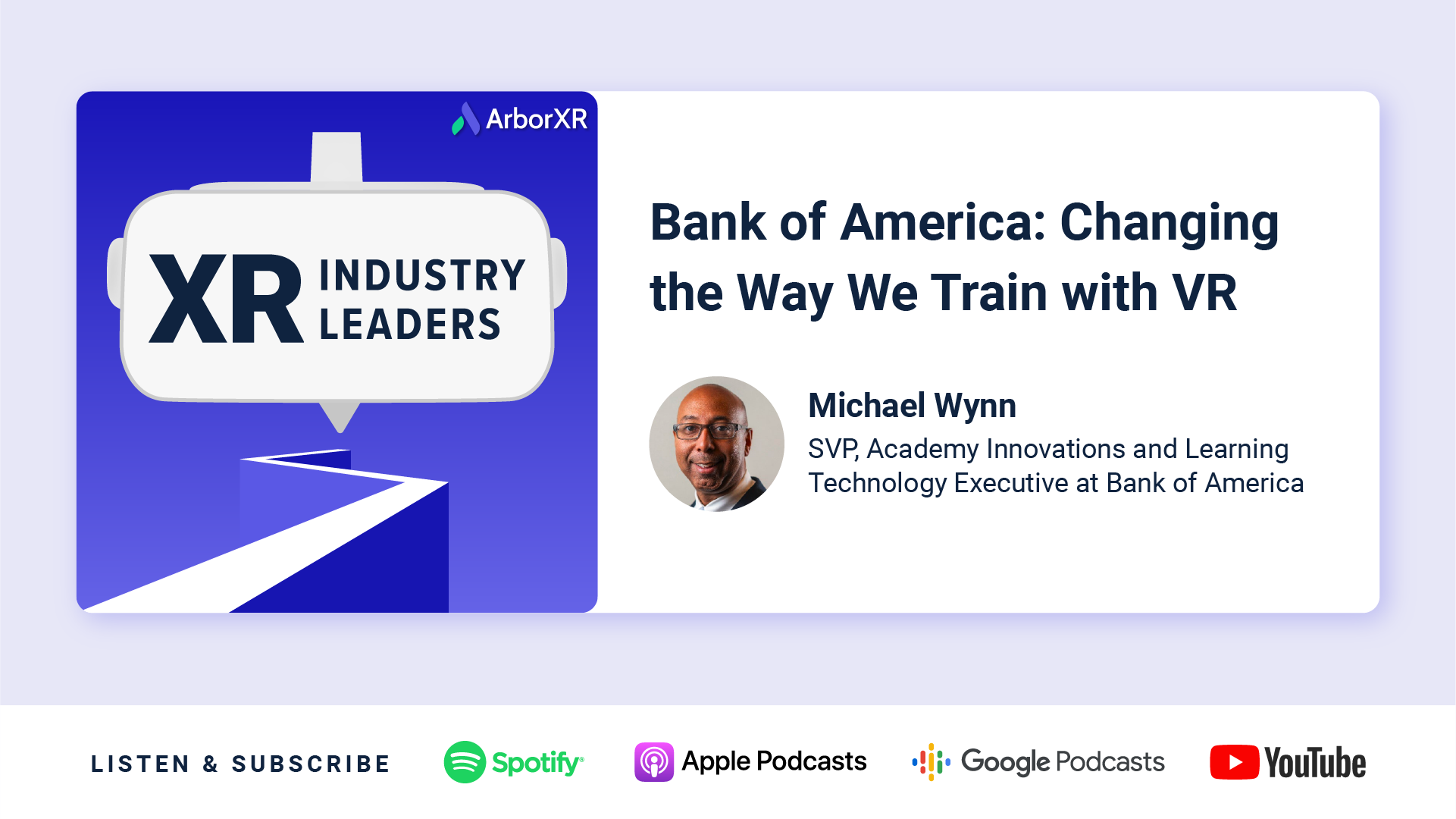
Bank of America: Changing the Way We Train with VR
Explore how Bank of America is revolutionizing training with VR, enhancing employee engagement, overcoming challenges with VR, and redefining corporate education.
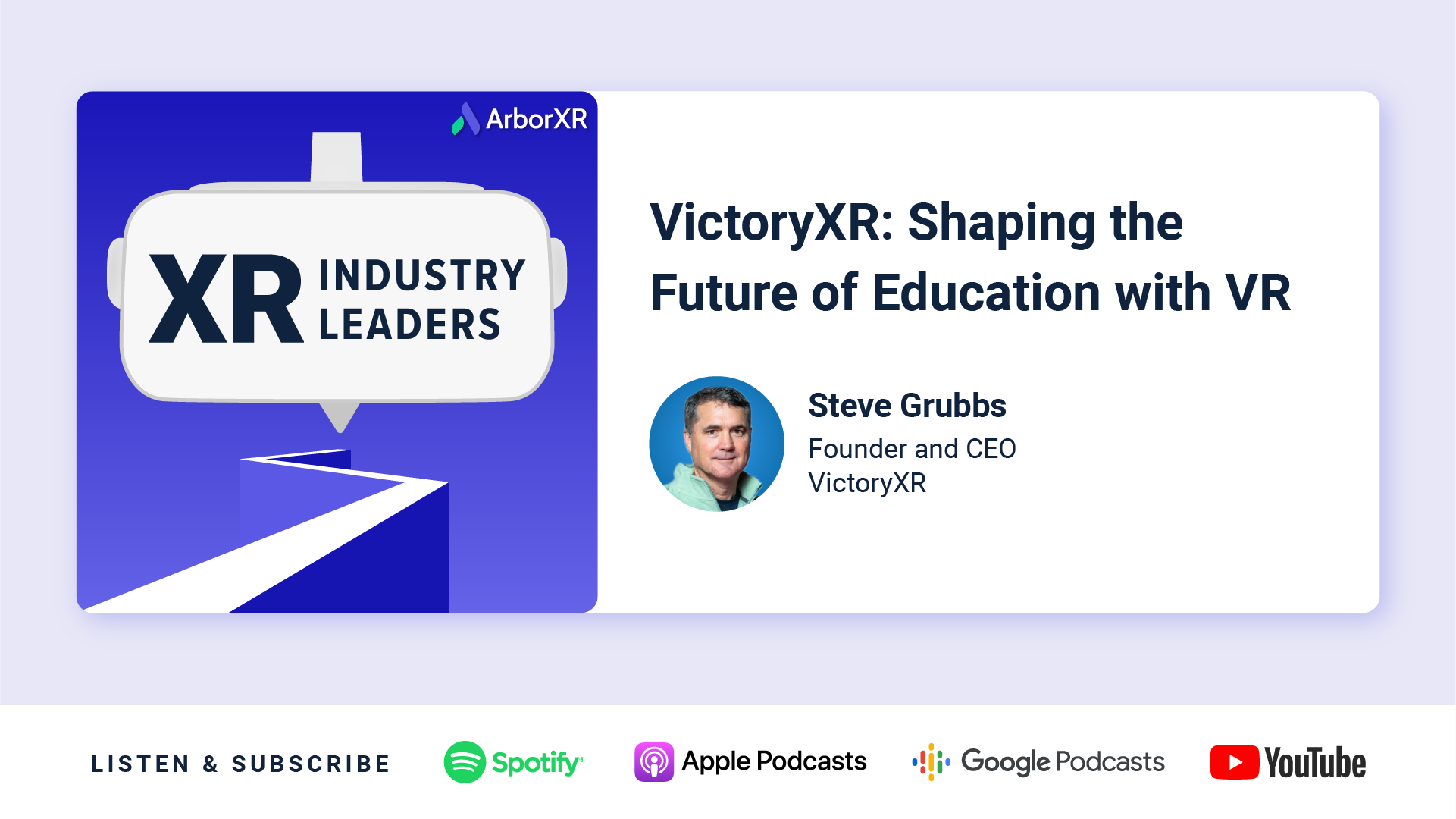
VictoryXR: Shaping the Future of Education with VR
VictoryXR CEO Steve Grubbs discusses creating virtual reality curriculums for education, working closely with Meta, and the future of immersive technology for teachers and students.

VRpatients: Designing Your Own VR Training for Healthcare
Learn how VRpatients creates VR simulations that instructors can customize to give trainees real-life experiences in healthcare.
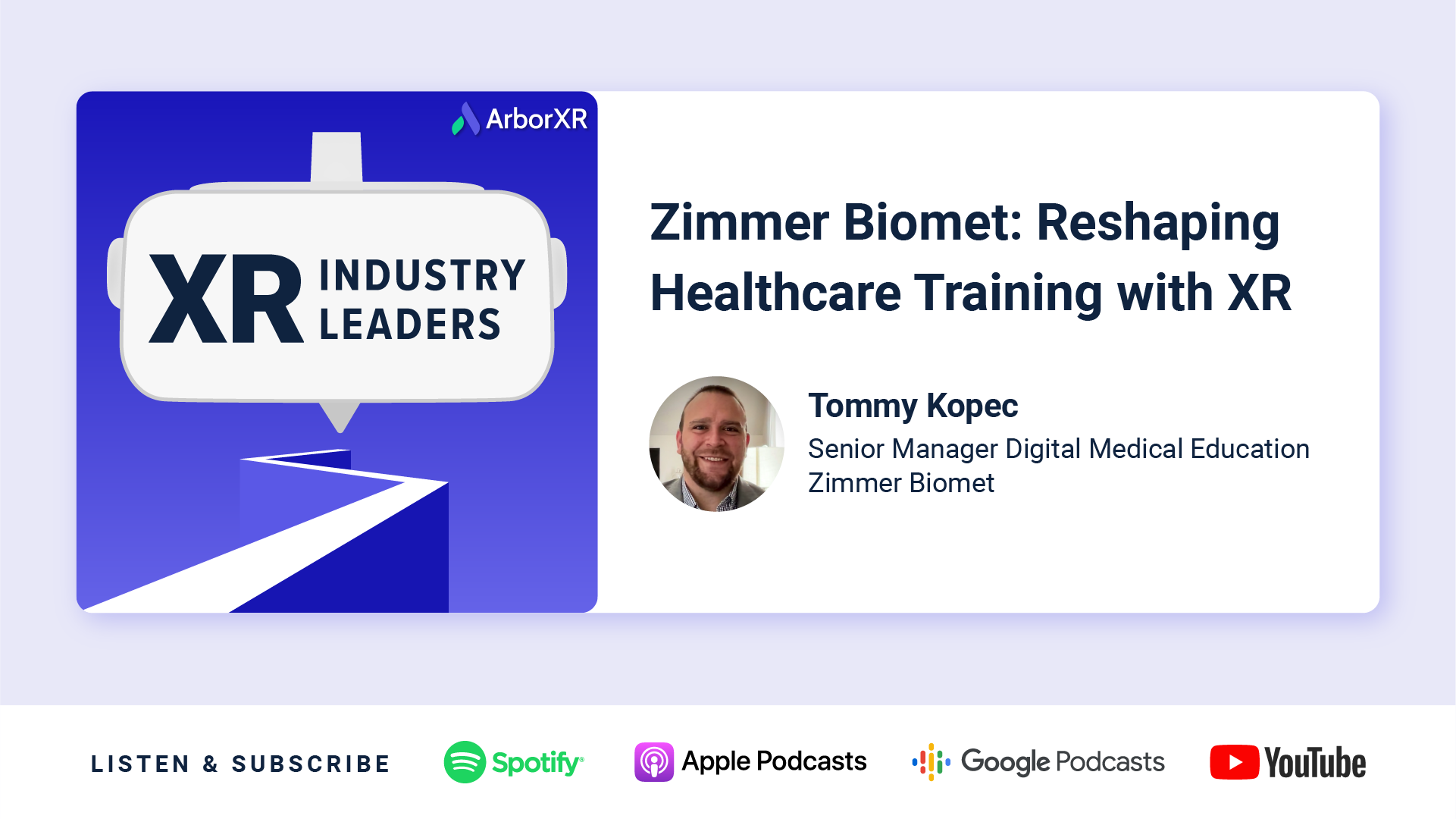
Zimmer Biomet: Reshaping Healthcare Training with AR and VR
If you’re interested in how XR will shape medicine going forward, this is a must-listen episode. Tommy Kopec of Zimmer Biomet provides an insider’s perspective on VR’s transformative potential for surgery, training, and beyond.

Lenovo: Unlocking Enterprise Potential with VR
Dive into the dynamic world of extended reality (XR) with Lenovo’s Vishal Shah and Jason McGuigan as they unravel Lenovo’s new enterprise XR solution: the Lenovo ThinkReality VRX.

PICO: Practical Enterprise Applications in XR at Scale
Explore XR’s future with PICO’s Amir Khorram in XR Industry Leaders. Insightful discussion on VR enterprise solutions, partnerships, and industry adoption.

St. James’s Place: Elevating Soft Skills with VR
Hannah & Josh St. James’s Place discuss using VR to train advisor soft skills, challenges of managing headsets at scale, lessons on user adoption, and content development.

MyndVR: Senior Care and Digital Therapeutics with VR
Chris Brickler shares how VR therapy improves memories and care for elderly patients, and the challenges of scaling VR across health senior care facilities.

MDA: Training For Outer Space Operations with VR
Discover how MDA leverages VR for astronaut training, mission planning, and onboarding. Gain valuable insights into implementing immersive technologies at scale.

Harvard: Experiential VR Learning in Education
Matt Cook from Harvard joins us to discuss how virtual & augmented reality are redefining higher education through customized immersive experiences.
